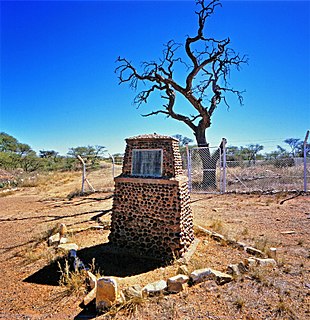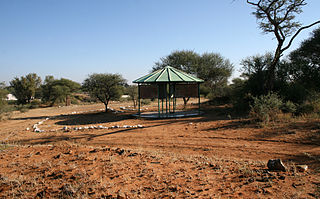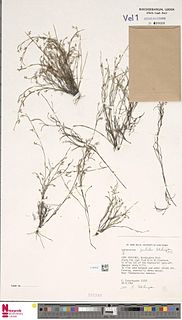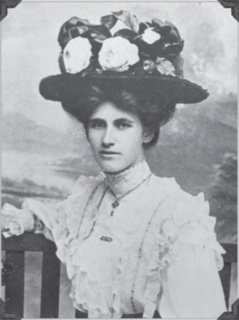
Barkly West is a town in the Northern Cape province of South Africa, situated on the north bank of the Vaal River west of Kimberley.

Selmar Schonland, originally spelt Schönland, the founder of the Department of Botany at Rhodes University, was a German immigrant, who came to the Eastern part of the Cape Colony in 1889 to take up an appointment as curator of the Albany Museum. He came to Grahamstown via a doctorate at the University of Hamburg and a post at Oxford University. Working under Prof. Sir Isaac Bayley Balfour and Prof. Sydney Howard Vines, he developed an interest in the family Crassulaceae and contributed an account of this group to Engler & Prantl's Natürl. Pflanzenfamilien.

The McGregor Museum in Kimberley, South Africa, originally known as the Alexander McGregor Memorial Museum, is a multidisciplinary museum which serves Kimberley and the Northern Cape, established in 1907.

Sclerophrys poweri is a species of toad in the family Bufonidae. It is found in extreme southern Angola, northern Namibia, Botswana, southward to central South Africa, and Zambia. The specific name poweri honours John Hyacinth Power, Irish-born director of the McGregor Museum who collected amphibians as well as reptiles and plants.

Hyperolius poweri is a species of frogs in the family Hyperoliidae. It is found in southeastern coast of South Africa and southern Mozambique. The specific name poweri honours John Hyacinth Power, Irish-born director of the McGregor Museum who collected amphibians as well as reptiles and plants. Accordingly, common names Power's reed frog and Power's long reed frog have been proposed for this species.

Breviceps poweri, the Power's rain frog or Power's short-headed frog, is a species of frog in the family Brevicipitidae. It is found in northeastern Angola east through Zambia, southern Democratic Republic of the Congo, and Malawi, to western Mozambique and northeastern Zimbabwe; possibly in Namibia. The specific name poweri honours John Hyacinth Power, Irish-born director of the McGregor Museum who collected amphibians as well as reptiles and plants.
Wildebeest Kuil Rock Art Centre is a rock engraving site with visitor centre on land owned by the !Xun and Khwe San situated about 16 km from Kimberley, Northern Cape, South Africa. It is a declared Provincial Heritage Site managed by the Northern Cape Rock Art Trust in association with the McGregor Museum. The engravings exemplify one of the forms often referred to as ‘Bushman rock art’ – or Khoe-San rock art – with the rock paintings of the Drakensberg, Cederberg and other regions of South Africa being generally better known occurrences. Differing in technique, the engravings have many features in common with rock paintings. A greater emphasis on large mammals such as elephant, rhino and hippo, in addition to eland, and an often reduced concern with depicting the human form set the engravings apart from the paintings of the sub-continent.
The Malay Camp in Kimberley, South Africa, was a cosmopolitan suburb which was subject to forced removals prior to the Group Areas Act.
Maria Wilman was a South African geologist and botanist. She was the first Director of the McGregor Museum in Kimberley, South Africa and the second female South African to attend the University of Cambridge in England.
Alfred Martin Duggan-Cronin was an Irish-born South African photographer who undertook several photographic and collecting expeditions in South Africa and adjacent territories between 1919 and 1939, in the course of which he documented people and rural life throughout the subcontinent. Based in Kimberley, it was while working in the mine compounds that he initially encountered African migrant workers, stimulating an interest in ethnographic subjects. Duggan-Cronin was born on 17 May 1874 in Innishannon, County Cork, Ireland, and died on 25 August 1954 in Kimberley, South Africa..

Canteen Kopje is an archaeological site, formally protected as a grade 2 provincial heritage site, and approved in 2017 for re-grading to national status, situated outside Barkly West in the Northern Cape, South Africa. The place was previously known as Klipdrift, meaning stony drift, a translation from a still earlier !Ora name, !a |aub. Canteen Kopje is best known for its long and exceptionally rich Earlier Stone Age sequence, spanning circa >0.5 to 1.7 million years, occurring within gravels exposed in late nineteenth/early twentieth century mining pits. Also attracting attention are more recent archaeological levels in the overlying Hutton Sands, which contain material known as Fauresmith, Middle Stone Age, Later Stone Age, and late Iron Age with evidence of protocolonial/colonial contact and interaction, probably, with nineteenth century diamond diggers.
The Venerable Fr George Merwyn Lawson (1865–1945) served as archdeacon of Kuruman, 1913–1941, in the Anglican Diocese of Kimberley and Kuruman, and as Director of Missions for Griqualand West from 1903 until his death.
Richard Liversidge, naturalist, ornithologist and museum director, was born on 17 September 1926 in Blantyre, Nyasaland, and died on 15 September 2003 in Kimberley, South Africa.

Elsie Elizabeth Esterhuysen was a South African botanist. She was described as "the most outstanding collector ever of South African flora", amassing 36,000 herbarium specimens.
Elizabeth Anne Voigt was director of the McGregor Museum in Kimberley, South Africa, and, as an archaeozoologist, served a term as president of the South African Archaeological Society. In retirement, Voigt was appointed a research associate of the McGregor Museum. She was born in Cape Town on 26 April 1944 and died on 7 April 2010 in Kimberley.

William Frederick Purcell was an English-born South African arachnologist and zoologist. He is regarded as being the founder of modern araneology in South Africa.

Alfred Brown aka Gogga Brown was an English-born South African palaeontologist, archaeologist and naturalist whose contributions to science were considerable. Brown discovered 21 new species of fossil reptiles and dinosaurs, a large number of which were described by Robert Broom and Harry Seeley. The defunct genus Browniella and some ten fossil species were named in his honour. Brown's fossils included 7 new species of Triassic fishes, some found by other collectors, three of which were named after him. Brown published a solitary article on his finds - "The Dicynodon", appearing in the Cape Monthly Magazine. Despite having had no formal training in palaeontology, archaeology or natural history, Brown possessed an enquiring and orderly mind.

Daniel Rossouw Kannemeyer was a South African medical practitioner, naturalist, archaeologist and palaeontologist, the son of Daniel Gerhardus Kannemeyer and Johanna Susanna Rossouw He is best remembered for his contributions to palaeontology and archaeology although his collections of zoological specimens are greatly valued by the museums which acquired them.

Peter Bernhard Beaumont was a South African archaeologist noted for his excavation and finds at Wonderwerk Cave, Kathu, Canteen Kopje and Border Cave, all in South Africa. His work led to the conviction that, rather than trailing Europe and Asia, Southern Africa's Stone Age technology and culture had set the pace.

Constance Georgina Adams, also known as Constance Georgina Tardrew, was a South African housewife and collector of botanical specimens. Known by the nicknames Connie and Daisy, Adams was born in Cape Town and spent her early childhood on a farm in Tulbagh before moving to Warrenton. She subsequently lived in Kimberley before getting married, settling in Johannesburg where she became active in the Housewives League of South Africa. Inspired by her parent's interest in botany, she became a successful collector for both the Albany Museum in Grahamstown and McGregor Museum in Kimberley. She also cultivated a friendship with the Director of the latter, Maria Wilman. She collected over 240 specimens, which were presented to the Albany Museum, McGregor Museum and the National Herbarium in Pretoria.












